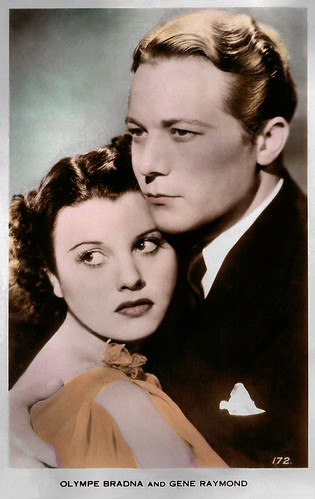
British hand-coloured Real Photograph postcard in the Colourgraph Series, London, no. C 399. Photo: Paramount.

British postcard by Art Photo, no. 172. Photo: Olympe Bradna and Gene Raymond in Stolen Heaven (Andrew L. Stone, 1938).
Born in a dressing room in the Olympia
Antoinette Olympe Bradna was born in 1920 in a dressing room in the Olympia Theatre in Paris, in between a matinée and an evening performance. Her father, Joseph Bradna, was a Bohemian Czech and her mother, Jana Bradna, was Austrian German.
They were circus performers but Jana had been an opera singer before she joined her husband in the circus. Her aunt also was in the circus, as an equestrienne. The dog act of her parents featured at the famous Olympia Theatre - hence her first name.
Trained by her dad, Olympe soon joined the family business, at only 18 months of age. By the time she was 8, Bradna "had attracted so much attention that agents were anxious to book her as a 'single'", according to Wikipedia.
Her parents accompanied her to Sweden, Norway, Germany, Switzerland, Italy, and France. She performed an acrobatic dance in a French production of the Broadway musical 'Hit the Deck', billed as the "tiniest sailor in France". Later she joined the Folies Bergère. She was with that group for eight months and danced at the French Casino in New York City for eight more months.
Olympe Bradna started her film career in France. She made her film debut in the French historical drama Roger la Honte (Gaston Roudès, 1933) starring Constant Rémy, Germaine Rouer, and France Dhélia. It is an adaptation of the 1886 novel of the same name by Jules Mary.

German cigarette card by Ross Verlag in the 'Künstler im Film' series for Zigarettenfabrik Monopol, Dresden, Serie 1, image 146 (of 200). Photo: Paramount.
Pronounce her first name as 'O-lamp'
In 1934, Olympe Bradna joined an American company of the Folies Bergere as an acrobatic dancer for Chicago's World Fair. She then performed for eight months at the French Casino in New York, where she was 'discovered' by Paramount talent scouts and discreetly signed a seven-year contract. In 1935, she was one of seven young women named by Paramount as possible screen stars of the future. For three months, Olympe was tutored in English, tap dancing, and horse riding.
Her screen debut came in the musical Three Cheers for Love (Ray McCarey, 1936), starring Eleanore Whitney and Robert Cummings. She was introduced by a famous publicity campaign, which instructed prospective American audiences to pronounce her first name 'O-lamp' ;In 1936, she also appeared in the comedy College Holiday (Frank Tuttle, 1936) but according to I.S. Mowis at IMDb "her tiny role was totally submerged by the antics of star comedians Jack Benny, George Burns, Gracie Allen, and Martha Raye."
Later, she branched out from musicals to more serious films and had roles in the war drama The Last Train from Madrid (James P. Hogan, 1937) with Dorothy Lamour and Lew Ayres, and the adventure film Souls at Sea (Henry Hathaway, 1937) with Gary Cooper and George Raft.
Her first leading role was opposite Gene Raymond in Stolen Heaven (Andrew L. Stone, 1938), a forgettable B-film about a couple of jewel thieves on the run. This was followed by the Ray Milland comedy Say It in French (Andrew L. Stone, 1938) and a sentimental theatrical drama, The Night of Nights (1939), which flopped despite a script by Donald Ogden Stewart and directed by Lewis Milestone. On loan to Warners, she made three more films. In 1941 Olympe married Santa Barbara socialite Douglas Woods Wilhoit, at which point she retired from acting. Her final film was the American war film International Squadron/Flight Patrol (Lewis Seiler, Lothar Mendes, 1941), starring Ronald Reagan.
For many years she and her family lived in Stockton, California, before ultimately settling in Lodi, California. They were married for over seventy years, with Douglas passing away in February 2012, just nine months prior to Olympe's death. Bradna died in 2012, in Stockton, California, at age 92. She was survived by a son, two daughters, five grandchildren, and eight great-grandchildren.

French postcard by EPC, no. 208. Photo: Paramount.

British postcard. Photo: Paramount.
Sources: I.S. Mowis (IMDb), Wikipedia, and IMDb.
This post was last updated on 29 July 2023.
No comments:
Post a Comment